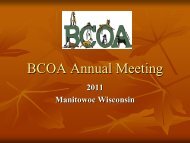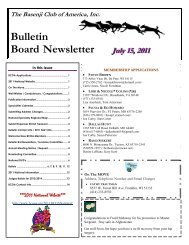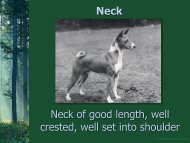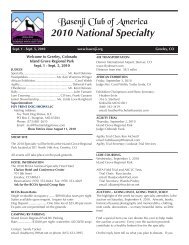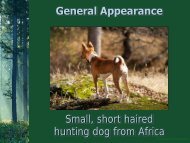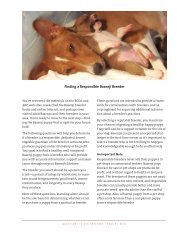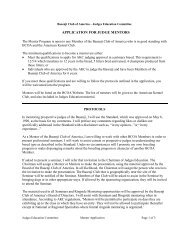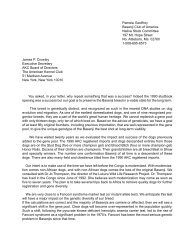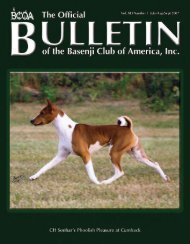y Linda Siekert - Sinbaje <strong>Basenji</strong>sTHE BREED STANDARD -Ano<strong>the</strong>r Point <strong>of</strong> ViewI ALWAYS ENJOY READING Mary Lou Kenworthy’s Point<strong>of</strong> View. Though I might not always agree with her premise, Ican always rely on her subject matter eliciting thought provokingideas and/or discussion; <strong>the</strong> Oct/Nov/Dec 2007 <strong>BCOA</strong> <strong>Bulletin</strong> isno exception. While <strong>the</strong>re were a number <strong>of</strong> points within herarticle I could easily remark upon, I have decided to just focus onone area <strong>of</strong> <strong>the</strong> standard that has vexed me for many years.Ms. Kenworthy writes: “In his excellent book, DogLocomotion and Gait Analysis, Curtis Brown says this <strong>of</strong> dogsand endurance, “In general, a somewhat long body is advantageousfor ei<strong>the</strong>r trotting or flexible back galloping, whereas a square bodyis advantageous for endurance galloping.” So <strong>the</strong> compromisemust go to <strong>the</strong> square body if <strong>the</strong> basenji is to get back home safelybefore <strong>the</strong> leopards come out. The “tireless trot” must be effortless,as asked for in <strong>the</strong> standard.”The argument for <strong>the</strong> square body equating to endurance seemsfaulty in relation to <strong>the</strong> basenji due to <strong>the</strong> fact that <strong>the</strong> basenji is notan endurance galloper (square body) but an endurance trotter (longbody); <strong>the</strong> ideal gait as mentioned in our 1990 breed standard, noless than three times, and described as early as <strong>the</strong> 1942 revisedBritish standard. If one support’s Mr. Brown’s premise <strong>of</strong> <strong>the</strong> longbody being <strong>the</strong> only body advantageous to ei<strong>the</strong>r a trot or a gallop,with <strong>the</strong> square body being solely for galloping, <strong>the</strong> tireless trotdescribed in <strong>the</strong> basenji standard must <strong>the</strong>n come from a longerbodied animal, not <strong>the</strong> square body Ms. Kenworthy is willing tocompromise for.Not too surprisingly Mr. Brown’s supposition is supported by<strong>the</strong> breed characteristics <strong>of</strong> <strong>the</strong> American Trotter (also known as <strong>the</strong>Standardbred), <strong>the</strong> only horse that races in a full out trot, to whichour standard ultimately compares. The US Trotting Association, orUSTA, <strong>the</strong> American Trotter/Standardbred registrar, has this to sayabout <strong>the</strong> breed: “In many respects, <strong>the</strong> Standardbred resembles<strong>the</strong> Thoroughbred. However, it is <strong>of</strong>ten more muscled and longerin body, and does not stand as tall, averaging between 15 and16 hands.” How interesting! The animal in which ideal basenjimovement is greatly compared is a short, long bodied beast;sounding more like native African basenjis from which our breeddescends and less like <strong>the</strong> aes<strong>the</strong>tic, dare I say generic, basenjisseen too <strong>of</strong>ten in <strong>the</strong> ring today.Ms. Kenworthy’s article once again encouraged me to pick up,and pick through, <strong>the</strong> 1990 American basenji standard, and onceagain my interpretation is stymied by obvious contradictions foundwithin, including but not limited to, asking for a short backed, highon leg, presumably “square” dog, though <strong>the</strong> word square is neverused in our standard in relations tobody style, while describing a gaitthat “resembles a racehorse trottingfull out” - a gait which, according toMr. Brown et al, needs a long body.The questions for me become: Doesa long body always equate to a longback or could properly angled, andplaced, front and rear assembliescreate <strong>the</strong> impression <strong>of</strong> length?Does a long body always meanshort legs or could <strong>the</strong> leg length becorrect but due to <strong>the</strong> proper depthThe <strong>Basenji</strong> <strong>Club</strong> <strong>of</strong> America, Inc. BULLETIN - 28<strong>of</strong> chest, described as deep in <strong>the</strong> standard from its very inception,thus making <strong>the</strong>m appear somewhat shorter <strong>the</strong>n <strong>the</strong>ir shallowchested, albeit leggier looking, brethren?Which <strong>of</strong> course leads to <strong>the</strong> question - just what does“appearing high on <strong>the</strong> leg” actually mean with regards to properstructure? I personally have never seen a true “high on <strong>the</strong> leg,compared to its length” basenji - by true I mean one that did nothave a structural fault giving <strong>the</strong> appearance <strong>of</strong> height; straightangles, shallow chests, front assemblies glued under its chin,pasterns so stiff and upright you could snap ‘em like twigs ormistake <strong>the</strong>m for terriers. Nor can I recall ever seeing a well-puttoge<strong>the</strong>r,soundly moving basenji and thinking, “Gee - that dog’son stilts!” Where does <strong>the</strong> appearance <strong>of</strong> height come from if notvia structural faults, up to and including, loss <strong>of</strong> important depth <strong>of</strong>chest?You can see my quandary, as I am forever questioning exactlyhow <strong>the</strong> breed standard evolved when so little <strong>of</strong> it actuallyresembles <strong>the</strong> native dogs our breed is founded upon. It’s as thoughwe imported ten native specimens, nine <strong>of</strong> which had large ears,and declared <strong>the</strong> one with smaller ears a typical characteristic <strong>of</strong><strong>the</strong> breed, and said as much in our breed standard (albeit 15 yearsafter <strong>the</strong> first two standards were written and accepted!). Over <strong>the</strong>course <strong>of</strong> 69 years <strong>the</strong> breed standard has changed a number <strong>of</strong>times and with each revision <strong>the</strong> ready made animal <strong>of</strong> which ourbreed descends becomes nothing more <strong>the</strong>n a forgotten steppingstone to <strong>the</strong> generic, man made mediocrity we see too <strong>of</strong>ten today.‘Tis a shame really, especially when we have been afforded uniqueopportunities in previous, and future years, to actually go backto <strong>the</strong> source <strong>of</strong> our founders and recover much <strong>of</strong> what we havelost; well laid back shoulders as described in many ways in everyBritish standard since <strong>the</strong> first <strong>of</strong> 1939, long second thighs, depth<strong>of</strong> chest, point <strong>of</strong> chest - to name just a few.In conclusion, please see <strong>the</strong> photo comparison below <strong>of</strong> twohorses, approximate age unknown, in a similar gait sequence at<strong>the</strong> trot, naturally in a field without human guidance. One is apureblood Arabian, a breed known for <strong>the</strong>ir ‘high on leg, shortbacked appearance’; <strong>the</strong> body style implied in our breed standard.The o<strong>the</strong>r, <strong>the</strong> Standardbred, is known for <strong>the</strong>ir longer bodies andshorter stature but whose gaiting style <strong>the</strong> basenji is supposed toemulate. Note <strong>the</strong> difference in reach and drive between <strong>the</strong> two?The questions are: which body style is correct for our breed?Which gaiting style is correct for our breed? And which is mostimportant; body style which creates a pretty picture or movementnecessary for <strong>the</strong> all day hunt? You be <strong>the</strong> judge.y
FROM THE OFA HEALTH FILEBreedTHYROIDISM IN BASENJIS – BASED ON STATISTICS FROM MICHIGAN STATE UNIVERSITYBreed Rank Number <strong>of</strong> Evaluations Percent Autoimmune Thyroiditis Percent EquivocalBASENJI 35 741 10.8 5.5RankTHYROIDISM IN BASENJIS – BASED ON STATISTICS FROM OFANumber <strong>of</strong>EvaluationsPercentNormalPercent AutoimmuneThyroiditisPercent IdiopathicHypothyroidismPercent EquivocalBASENJI 13 93 77.4 9.7 0.0 12.9General Thyroid InformationAutoimmune thyroiditis is <strong>the</strong> most common cause <strong>of</strong> primaryhypothyroidism in dogs. The disease has variable onset, but tendsto clinically manifest itself at 2 to 5 years <strong>of</strong> age. Dogs may beclinically normal for years, only to become hypothyroid at alater date. The marker for autoimmune thyroiditis, thyroglobulinautoantibody formation, usually occurs prior to <strong>the</strong> occurrence <strong>of</strong>clinical signs. Therefore, periodic retesting is recommended.The majority <strong>of</strong> dogs that develop autoantibodies have <strong>the</strong>m by 3to 4 years <strong>of</strong> age. Development <strong>of</strong> autoantibodies to any time in <strong>the</strong>dog’s life is an indication that <strong>the</strong> dog, most likely, has <strong>the</strong> geneticform <strong>of</strong> <strong>the</strong> disease. Using today's technology only a small fraction<strong>of</strong> false positive tests occur.As a result <strong>of</strong> <strong>the</strong> variable onset <strong>of</strong> <strong>the</strong> presence <strong>of</strong> autoantibodies,periodic testing will be necessary. Dogs that are negative at 1year <strong>of</strong> age may become positive at 6 years <strong>of</strong> age. Dogs shouldbe tested every year or two in order to be certain <strong>the</strong>y have notdeveloped <strong>the</strong> condition. Since <strong>the</strong> majority <strong>of</strong> affected dogs willhave autoantibodies by 4 years <strong>of</strong> age, annual testing for <strong>the</strong> first 4years is recommended. After that, testing every o<strong>the</strong>r year shouldsuffice. Unfortunately, a negative at any one time will not guaranteethat <strong>the</strong> dog will not develop thyroiditis.The registry data can be used by breeders in determining whichdogs are best for <strong>the</strong>ir breeding program. Knowing <strong>the</strong> status <strong>of</strong><strong>the</strong> dog and <strong>the</strong> status <strong>of</strong> <strong>the</strong> dogs lineage, breeders and geneticcounselors can decide which matings are most appropriate forreducing <strong>the</strong> incidence <strong>of</strong> autoimmune thyroiditis in <strong>the</strong> <strong>of</strong>fspring.Dogs should not receive any type <strong>of</strong> thyroid supplementation for 3months prior to thyroid testing.OFA Thyroid ProceduresPurposeTo identify those dogs that are phenotypically normal forbreeding programs and to ga<strong>the</strong>r data on <strong>the</strong> genetic diseaseautoimmune thyroiditisExamination and ClassificationEach dog is to be examined by an attending veterinarian andhave a serum sample sent to an OFA approved laboratory for testingaccording to <strong>the</strong> enclosed application and general informationinstructions. The laboratory fee will be determined by <strong>the</strong> approvedlaboratory. All OFA forms and <strong>the</strong> OFA fee are submitted with <strong>the</strong>sample to <strong>the</strong> approved lab. Check with <strong>the</strong> referral laboratory forspecial sample handling and tests for registry purposes.CertificationA breed database number <strong>of</strong> will be issued to all dogs foundto be normal at 12 months <strong>of</strong> age. Ages will be used in <strong>the</strong>certification process since <strong>the</strong> classification can change as <strong>the</strong> dogages and <strong>the</strong> autoimmune disease progresses. It is recommendedthat reexamination occur at ages 2,3,4,6, and 8 years.Preliminary EvaluationEvaluation <strong>of</strong> dogs under 12 months <strong>of</strong> age can be performedfor private use <strong>of</strong> <strong>the</strong> owner since <strong>the</strong> few dogs are already positiveat that age. However, certification will not be possible at that age.Dogs with Autoimmune ThyroiditisAll data, whe<strong>the</strong>r normal or abnormal is to be submitted forpurposes <strong>of</strong> completeness. There is no OFA fee for entering anabnormal evaluation <strong>of</strong> <strong>the</strong> thyroid into <strong>the</strong> data bank. Informationon results determined to be positive or equivocal will not be madepublic without explicit written permission <strong>of</strong> <strong>the</strong> owner.Thyroid AbnormalitiesThyroid abnormalities fall into several categories—two typeswill be defined by <strong>the</strong> registry.Autoimmune ThyroiditisIdiopathically Reduced Thyroid FunctionAutoimme thyroiditis is known to be heritableEquivocal ResultsThose dogs with laboratory results that are questionable,<strong>the</strong>refore not definitive, will be considered as equivocal. It isrecommended that <strong>the</strong> test <strong>the</strong> repeated in three to six months.The laboratory certification process will include qualitycontrol, quality assurance and reagent certification. Laboratoriesmay apply and, if successful, will be approved to perform analysisfor OFA thyroid certification. A site visit by a qualified veterinaryendocrinologist chosen by <strong>the</strong> OFA will be required and continuedquality assurance and quality control will be necessary to maintaincertification. Fully certified status can be obtained by passing <strong>the</strong>site visit and passing <strong>the</strong> results <strong>of</strong> <strong>the</strong> first OFA quality assuranceassay result test. The approved laboratory must be contacted for<strong>the</strong> appropriate submission forms, sample handling procedures,and laboratory service fee before collecting <strong>the</strong> sample.SEE THE FOLLOWING PAGE FOR LABORATORIESThe <strong>Basenji</strong> <strong>Club</strong> <strong>of</strong> America, Inc. BULLETIN - 33



